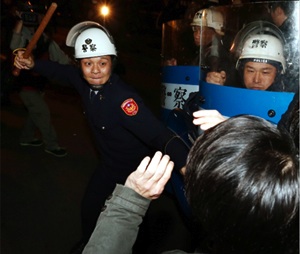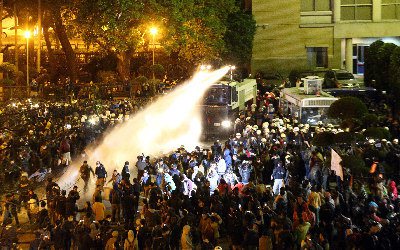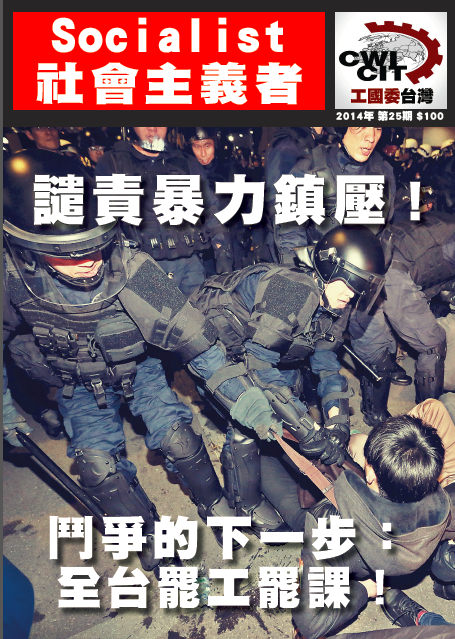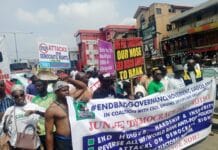Down with undemocratic Kuomintang rule – for a Taiwan-wide student strike as the next step!
Sally Tang Mei-ching in Taipei and Vincent Kolo
Tens of thousands of protesters have filled the streets around the occupied Taiwanese legislature for the past week. The Wall Street Journal calls this “the biggest student-led protest in Taiwan’s history.” After six years in power, a succession of crises and top-level splits, and a collapse in opinion poll ratings to 9 percent, Taiwan’s beleaguered president Ma Ying-jeou is fighting for his political survival.
The trigger for mass unrest was the decision of Ma and his Kuomintang (KMT, Chinese Nationalist Party) government to railroad through the legislature the deeply unpopular Cross-Strait Services Trade Agreement (CSSTA) with China. This deal, signed by the two governments in June last year, further deregulates both economy’s service sectors in favour of big business at the expense of jobs, wages and workers’ rights.
As the saying goes, “a week is a long time in politics.” Mass anger, especially since the government ordered a brutal police assault on the night between Sunday and Monday (23-24 March) in a failed attempt to subdue the protests, could turn the trade pact into a secondary problem for Ma, as the protests morph into a more generalised anti-government struggle echoing the movements last year in Turkey, Brazil and Ukraine. As one blog post noted the struggle has, “upgraded from opposing [an] unjust trade pact to a war for Taiwan’s democracy!”
Oppose neo-liberal trade pact
The government’s decision to fast-track ratification of the CSSTA pact, using its comfortable parliamentary majority (which massively exaggerates its real social base), was widely seen as the KMT reverting to its dictatorial traditions. There are widespread fears not only over the state of the economy but also over the erosion of press freedom and democratic rights, reinforced by the government’s increasingly close ties with the Chinese dictatorship.
The answer was given when around 300 students started the first-ever occupation inside the main chamber of the Legislative Yuan on Tuesday 18 March, generating enormous sympathy. Tens of thousands have poured onto the streets of the capital Taipei, with solidarity protests in other cities. The occupiers barricaded themselves inside the chamber and repelled an initial police attempt to evict the occupation.
The Committee for a Workers’ International (CWI) and its small forces in Taiwan, who are taking part every day in the protests outside the legislative compound, have consistently opposed Ma’s cross-strait agenda of détente and closer ties with Beijing, but from a class rather than an economic nationalist perspective. The government’s policies are driven by the demands of the capitalists in Taiwan, China, and globally, to further skew economic development in favour of the wealthy at the expense of the masses.
CSSTA is no exception. If enacted it will speed up outsourcing and the growth of temporary contracts at the expense of real jobs. Official statistics show that the number of part-time, temporary and dispatch workers in Taiwan totalled 539,000 in 2013, a 7-fold rise in the past decade. In real terms workers’ wages are lower today than 15 years ago. This is a condemnation of both Taiwan’s major political blocs which have led governments in this period: the KMT-led ‘pan blues’ (pro-China) and their ‘pan green’ (anti-China) opponents, led by the Democratic Progressive Party (DPP).
Both blocs, while trading verbal blows over Taiwan’s ‘cross-strait’ relationship with mainland China, stand for capitalist economic policies, the logic of which is to promote closer ties with China as the world’s number two economy and the major source of the Taiwanese capitalists’ profits. This is also the case with CSSTA, which the DPP does not oppose in its entirety but merely wants to amend. In effect, the DPP stands for a ‘lite’ version of CSSTA, a fact that is not lost on the youth demonstrating around the legislative compound. Many are angered by the DPP leaders’ antics both in trying to hi-jack the protests for their own election campaign and in not rejecting the trade pact in its entirety.
State violence
The political crisis escalated sharply on Sunday 23 March with young demonstrators entering the Executive Yuan (Cabinet Office) to spread the occupation. This action arose from divisions among the students, with growing frustration among more radical youth over what is perceived as a more conciliatory line from the main student group leading the protests which relies on the DPP politicians to act as go-betweens with the government.
Police responded with massive force to evict the demonstrators with 158 injured and over 60 arrests, Rather than a response to the occupation of the Executive Yuan, this crackdown was almost certainly planned in advance – to take place on Sunday night when the police and government calculated the ranks of the demonstrators would be fewer. A hint of what was coming was contained in president Ma’s televised speech earlier the same day, in which he stubbornly defended the CSSTA pact, but also warned the students to end their “illegal” occupation and respect “the rule of law”. Within hours of this speech the president’s shock troops – 3,000 riot police according to media reports – delivered a lesson in what the capitalist politicians mean by “rule of law.”
On the day of the police attack a spokesperson for the Obama administration, Marie Harf of the State Department, praised “Taiwan’s vibrant democracy.” For the youth and many ordinary citizens watching the news from home, the violent images of the crackdown were a flashback to the decades of grim KMT dictatorship and underline just how fragile democratic rights are in a capitalist system where real decision-making power is always monopolised by a tiny elite. Many have also compared the police attack to the 1989 crackdown in Beijing (although a more accurate comparison is to Deng Xiaoping‘s failed attempt at repression of 26-27 April 1989, which backfired completely).
Monday’s police assault lasted for five hours and ended with the deployment of water cannon spraying peppered water. There are many accounts on social media of police aiming their blows at the heads and necks of protesters including young women. In total seven waves of riot police waded into the non-violent crowds who were mostly engaged in a sit-down protest. A young woman sympathiser of the CWI told us what she saw from inside the occupation of the Executive Yuan, from where she was dragged out at 3am: “The police tactic was to drag a demonstrator behind the shields, where seven or eight policemen would beat them. Some of the police were laughing.”
A doctor in the crowd pleaded to be allowed to examine some of the wounded being held behind police lines, but was shooed away. A CWI member described how water cannon trucks moved in at around 4.30am on Monday: “It was unprovoked. The crowd pushed [the wagon] back by forming a blockade and walking towards it. The mood towards the police changed into outright hostility. It’s very lucky a riot wasn’t incited by the police actions.”
Self-defence and non-violence
With many similarities to the way the protest movements in Turkey and Brazil unfolded in 2013, the police assault, which was a conscious attempt to terrorise and break the spirit of the protests, has backfired and increased the pressure on Ma. To quote Karl Marx the “whip of counter-revolution” has further radicalised the situation and propelled the movement forward. At the same time, the threat of repression and “counter-revolution” is still tangible. While the riot police seem to have been caged for a while, gangs of thugs linked to the ruling party turn up late in the evenings to threaten the protesters. The issue of self-defence groups organised through democratic committees to patrol and protect the protest sites is now a vital one. This task should be linked to an appeal to workers’ unions to play a full role in the protests.
Debates about non-violence arise in nearly all contemporary protest movements not only in Taiwan. Among the student leaders Gandhian ideas (after Mahatma Gandhi) are very widespread. Unfortunately, not so many grasp that the struggle against British colonial rule in India was a revolutionary struggle and that international factors like the revolutionary struggle in China played a decisive role in weakening Britain’s hand. There is also a tendency to confuse militant methods or methods that challenge legality, with support for violence or actions that could “provoke repression.” These issues need to be discussed democratically throughout the movement. Socialists favour well-organised and disciplined mass struggle, rejecting vandalism and actions that politically play into the government’s hands. At the same time we believe that the mass protests need to organise defensive action against thugs, provocateurs and the state. For this level of organisation to be achieved democratic structures are needed and a clear programme to take the movement forward, which crucially hinges upon the working class becoming the leading force in the struggle and putting forward its own independent political representatives.
Strike call spreads
At the time of writing around 50 universities across Taiwan have voiced support for strikes and class boycotts. The need for a Taiwan-wide students’ strike as a first step, to then turn this towards the factories and workplaces and urge strike action by unions, has been a main plank of the CWI’s intervention in the current movement. Now, not only are students and teachers pushing for strikes, but this is also beginning to resonate among some layers of the working class. The government fears this development as shown by the comments of Premier Jiang Yi-hua, an especially hated figure after ordering the police crackdown, who warned that strikes would “seriously impair the state.”
CWI supporters are stressing the need for the student strike to be organised from below, through democratic campaign committees and student unions, rather than from above by the university or faculty elite. This strike movement should be collective, with mass meetings to explain and build active support, rather than the individual ‘autonomous’ approach envisaged by some academic groups.
It is the working class, however, that has the real muscle to defeat the government as Premier Jiang’s remarks testify. They are the key to victory in the struggle despite the conservatism of the union bureaucrats and numerical weakness of the trade unions. Many union bureaucrats have publicly rejected the call for a strike and pro-KMT union leaders have openly supported the CSSTA. The small Labour Party (a group with Stalinist roots), which controls some unions and led the Hualong textile factory strike in 2012 with the support of the protesting students, has kept silent on this issue. Despite these obstacles, a powerful strike movement among students can, if linked to a conscious turn to the working class for support, win significant support for the idea of workers’ strikes.
Tremors reach China
This struggle represents the most serious political crisis in Taiwan for decades. Although this is being deliberately downplayed, the crisis also presents a major challenge to the Chinese dictatorship. For Beijing the stakes involved go beyond the trade pact and even its wider Taiwan strategy, which consists of promoting the now badly damaged KMT regime and using economic agreements to pull the Taiwanese capitalist class into Beijing’s political orbit. Superficially, Ma’s cross-strait policies seemed to be crowned with successes, most recently with the first formal government-to-government talks in six decades (since the end of the Chinese civil war) held in Nanjing in February. But the other side of this process has been deepening public disenchantment with “mainlandisation” not just of Taiwan’s economy but also of its political system, as the politicians, big companies and the media compete to flatter Beijing.
While it is impossible to foresee every possible effect of the current protest movement, we are likely to see the political climate in Taiwan shift on its axis, giving a powerful boost to anti-China, pro-independence sentiment, and seriously undermining support for the pro-China strategy of Ma and the KMT.
“What Beijing is afraid to see is their dialogue with the governing Kuomintang in Taiwan, which so far has been very successful, is reaching its limits,” commented Jean-Pierre Cabestan of Hong Kong Baptist University.
For a Chinese dictatorship that is paranoid about mass opposition developing at home, the Taiwanese protests are as welcome as the Ukrainian protests were for Putin and the Russian state. This is especially since the shift in US military policy with its Asian Pivot of 2011 aimed at checking China’s increasing political and economic sway across Asia. For the past two decades Beijing and Washington have taken a broadly cooperative approach to the Taiwan issue, with both powers working to bolster the KMT and restrain independence sentiment. This ‘triangular relationship’ may not hold for much longer, however, with US imperialism increasingly determined to reassert itself in the region at Beijing’s expense.
At the same time, the mass struggle in Taiwan has exposed the conservatism of many Chinese liberals and ‘democrats’ whose posts on social media bemoan, “this is not the democracy we want,” and compare the Taiwan protests to the “chaos” of the Cultural Revolution in China.
The Taiwanese events represent a political minefield for the Chinese dictatorship, which includes the possibility of the KMT being ousted in the 2016 presidential elections in favour of the DPP. Splits have opened up within this party under the pressure of the Taiwan capitalists who are the main driver of Ma’s pro-China agenda. Especially since its election defeat in 2012, which its own analysis attributed to too hard a line against China, a wing has emerged within the DDP leadership that wants to tone down the party’s ‘old’ i.e. pro-independence rhetoric. Despite this, Beijing dreads the prospect of a DPP government returning to power, not because it fears the leaders, but rather the mass pressure they could come under – something we are seeing in the current movement.
The Chinese regime’s plan for Taiwan mainly centres on “stability” and preventing it shifting into open opposition to Beijing. A deepening of antagonisms across the Taiwan Strait risks aggravating China’s regional, national and religious conflicts. It is already the case that unrest in minority regions such as Xinjiang and Tibet is at its highest level for 30 years, as shown by the terrorist massacre in Kunming in March. Beijing fears the effects of rising support for Taiwan independence – already visible among the younger generation – in encouraging calls for independence or greater autonomy among the oppressed national minorities of China.
On yet another inter-connected front we already see how the Taiwan protests threaten the Chinese regime’s hand in Hong Kong, where a showdown looms over mass demands for a democratic election system. The movement in Taiwan has generated enormous sympathy in Hong Kong and increased the pressure upon the bourgeois leaders of the pro-democracy ‘Occupy Central’ movement, who have been seeking ways to demobilise the movement and compromise with Beijing. This week’s police crackdown in Taiwan is seen as a mirror of Hong Kong’s future struggle, with pro-government politicians threatening that the People’s Liberation Army could be deployed against protesters if ‘Occupy Central’ goes ahead.
There are key lessons in both these struggles, and the subterranean shifts taking place among the masses in China, as in the global protests and occupation struggles of recent years. The CWI plays a unique role by pooling the experiences of these mass movements, gathered from the CWI’s national sections which actively participate in these struggles, enabling us with the help of Marxist analysis to clarify and share the most important conclusions for future action.
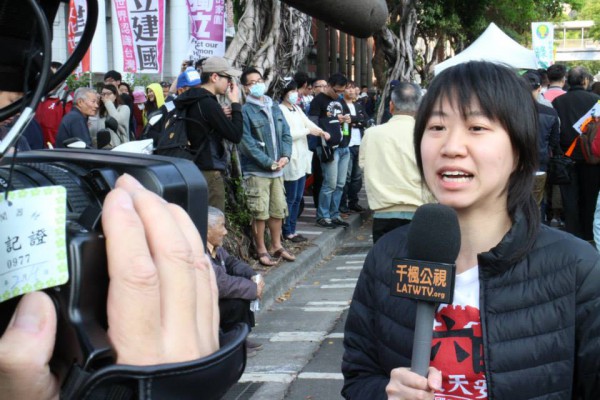
CWI in the demonstrations
The members of the CWI in Taiwan, with supporters joining from Hong Kong, have been active in the protest movement from the outset. We stand for a socialist alternative to capitalism and neo-liberal trade pacts like CSSTA, for the major companies and banks to be taken into democratic public ownership in order to break the grip of Taiwan’s billionaires over the economy and over government policy including cross strait policy. We stand for united working class struggle as the only way to defeat the capitalists and their governments. This means building a united movement together with the super-exploited migrant workers in Taiwan as well as winning support from workers internationally including in mainland China, where seven million are employed in Taiwanese-owned factories.
The socialist message of the CWI, while clearly a minority view within the movement at this stage, has already met a great response. Over 400 copies of the CWI Taiwan magazine (Socialist) were bought in a four-day period and many new faces have volunteered to help on the stalls. One activist was so impressed with our magazine and its analysis of the struggle that she bought 50 copies to distribute within her organisation.
The national question and the thorny issue of relations with China have receded into the background in recent years, with most people preferring “not to think about it.” But inevitably the latest protests will catapult this issue back into the spotlight. The protest movement, the working class and the forces of the left must be prepared for this and offer an answer that points the way towards united mass struggle. The CWI in Taiwan stands for the right of self-determination, meaning that if the people of Taiwan democratically choose independence we support this choice, which, however, can only be realised as part of an international socialist struggle against capitalism and its structure of foreign – imperialist – domination. Our anti-capitalist and socialist approach to the national question means complete opposition to the US and its military-diplomatic games in Asia, and against the military ambitions of other powers including China, Japan, but also of the Taiwanese capitalist state. The working class internationally and across Asia, mobilised around a socialist programme, is the only force capable of defeating capitalism and its war machines.
The main focus of CWI Taiwan and its supporters participating in the mass protests is to put forward proposals to escalate the movement and defeat the government, including the crucial question of a programme to draw the widest possible layers into the struggle and show how victory can be secured. This includes the following demands:
• Build for a Taiwan-wide student strike against the government – organise democratic strike committees in every school and university to link-up and coordinate the struggle. Appeal to workers and unions for solidarity action with a 24-hour general strike!
• Complete rejection of the Cross-Strait Services Trade Agreement!
• Down with Ma and the corrupt KMT government! Continue and step up the mass movement to force the government’s resignation and new elections!
• For an independent public investigation of the police crackdown of 23-24 March. Punish those responsible for planning this attack. Drop the charges against those arrested!
• Build a working class political alternative to the capitalist ‘pan blue’ and ‘pan green’ blocs. For a new workers’ party with socialist policies against the economic crisis and capitalism!
Are you in Taiwan? Want to help the CWI in the mass protests?
Call: 0983 252 840

